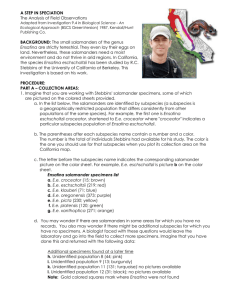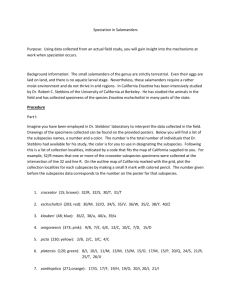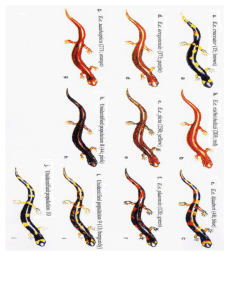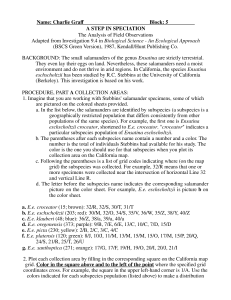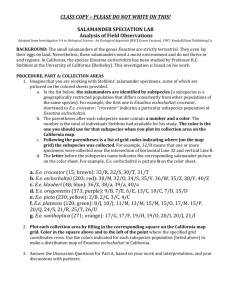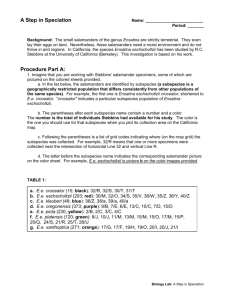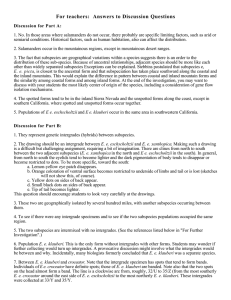Biology II Lab – Speciation
advertisement
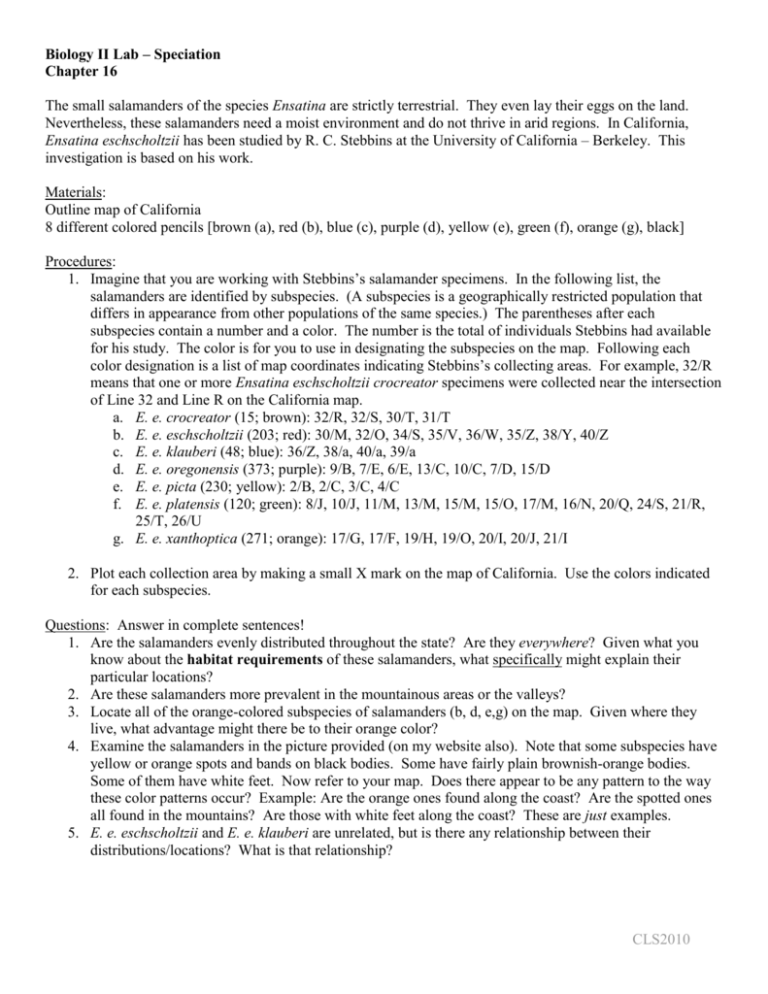
Biology II Lab – Speciation Chapter 16 The small salamanders of the species Ensatina are strictly terrestrial. They even lay their eggs on the land. Nevertheless, these salamanders need a moist environment and do not thrive in arid regions. In California, Ensatina eschscholtzii has been studied by R. C. Stebbins at the University of California – Berkeley. This investigation is based on his work. Materials: Outline map of California 8 different colored pencils [brown (a), red (b), blue (c), purple (d), yellow (e), green (f), orange (g), black] Procedures: 1. Imagine that you are working with Stebbins’s salamander specimens. In the following list, the salamanders are identified by subspecies. (A subspecies is a geographically restricted population that differs in appearance from other populations of the same species.) The parentheses after each subspecies contain a number and a color. The number is the total of individuals Stebbins had available for his study. The color is for you to use in designating the subspecies on the map. Following each color designation is a list of map coordinates indicating Stebbins’s collecting areas. For example, 32/R means that one or more Ensatina eschscholtzii crocreator specimens were collected near the intersection of Line 32 and Line R on the California map. a. E. e. crocreator (15; brown): 32/R, 32/S, 30/T, 31/T b. E. e. eschscholtzii (203; red): 30/M, 32/O, 34/S, 35/V, 36/W, 35/Z, 38/Y, 40/Z c. E. e. klauberi (48; blue): 36/Z, 38/a, 40/a, 39/a d. E. e. oregonensis (373; purple): 9/B, 7/E, 6/E, 13/C, 10/C, 7/D, 15/D e. E. e. picta (230; yellow): 2/B, 2/C, 3/C, 4/C f. E. e. platensis (120; green): 8/J, 10/J, 11/M, 13/M, 15/M, 15/O, 17/M, 16/N, 20/Q, 24/S, 21/R, 25/T, 26/U g. E. e. xanthoptica (271; orange): 17/G, 17/F, 19/H, 19/O, 20/I, 20/J, 21/I 2. Plot each collection area by making a small X mark on the map of California. Use the colors indicated for each subspecies. Questions: Answer in complete sentences! 1. Are the salamanders evenly distributed throughout the state? Are they everywhere? Given what you know about the habitat requirements of these salamanders, what specifically might explain their particular locations? 2. Are these salamanders more prevalent in the mountainous areas or the valleys? 3. Locate all of the orange-colored subspecies of salamanders (b, d, e,g) on the map. Given where they live, what advantage might there be to their orange color? 4. Examine the salamanders in the picture provided (on my website also). Note that some subspecies have yellow or orange spots and bands on black bodies. Some have fairly plain brownish-orange bodies. Some of them have white feet. Now refer to your map. Does there appear to be any pattern to the way these color patterns occur? Example: Are the orange ones found along the coast? Are the spotted ones all found in the mountains? Are those with white feet along the coast? These are just examples. 5. E. e. eschscholtzii and E. e. klauberi are unrelated, but is there any relationship between their distributions/locations? What is that relationship? CLS2010 Procedures: 3. After further collecting, the following salamanders were located: b. E. e. eschscholtzii (6: red): 36/Z, 39/Z, 32/M, 34/W, 34/U c. E. e. klauberi (23; blue): 40/b, 40/Z, 36/a h. Unidentified subspecies (44; black and green): 4/I, 5/H, 7/H, 7/F, 6/J, 9/F i. Unidentified subspecies (13; black and red): 28/T, 27/T, 26/T, 28/S, 29/T k. Unidentified subspecies (131; black and blue): 23/J, 24/K, 24/I, 29/M, 25/J, 25/I l. Unidentified subspecies (31; black and yellow): 6/C, 7/C, 6/B 4. Using any color pencil, mark with an O the following places where no salamanders were found: 11/I, 14/I, 17/K, 19/K, 22/N, 26/Q, 5/M, 32/U, 32/a, 35/f. Questions: 6. Unidentified subspecies h, i, k, and l are all considered crosses between two of the other Ensatina species. This is based on location, not appearance. Identify by name which two salamander species each of them is probably a cross between. 7. Why is it unlikely that you would ever find individuals that are hybrids of E. e. picta (yellow X’s) and E. e. xanthoptica (orange X’s)? 8. Look at the location of E. e. eschscholtzii (red X’s) and E. e. klauberi (blue X’s). What reasons might there be for trying to collect additional specimens from that area? 9. How do the results of the additional collections of E. e. eschscholtzii (red X’s) and E. e. klauberi (blue X’s) differ from the results in other areas where two different populations live in close proximity to each other? 10. Recall the biological definition of “species” and also the physical appearance and location of the named populations of Ensatina. Which one of these populations could be considered a possible separate species from E. e. eschscholtzii (red X’s)? Explain your reasoning. (This population was in fact once considered by biologists to be a separate species.) 11. Imagine that while examining salamanders in another collection, you find specimen “j” (see color photo). Compare its characteristics, especially the spotting pattern, with those of the other populations. Also consider the location of these populations. Between which two is this specimen most likely a hybrid? On your map draw a line in red along which you might find more of this particular specimen. 12. What is the most likely explanation for the one sighting of E. e. xanthoptica (orange X’s ) in the Sierra Nevada Mountains, while the rest of that population occurs along the coast? How did it get there? Final Instructions: Do not turn in this paper! Type your answers to all of the questions on plain white paper. Make sure you respond in complete sentences. Include your name and class period on the top of the page. Staple your map to the back of your answers. Indicate who your partner was. Please turn in on time as there is a 50% deduction for late work! CLS2010
